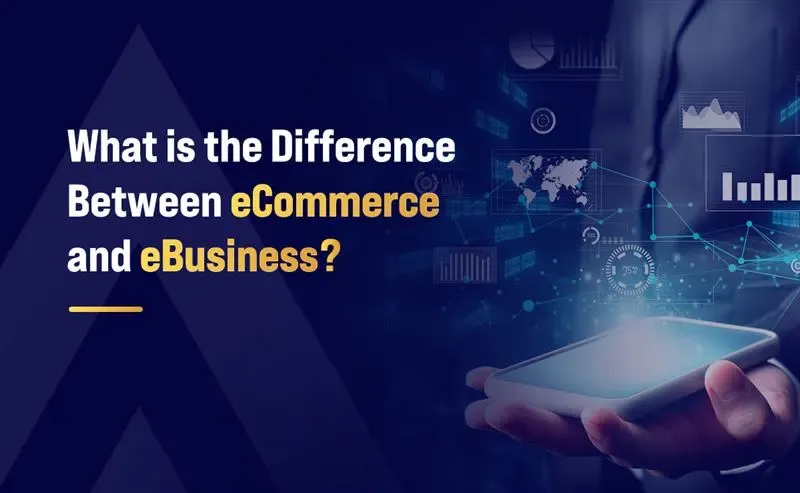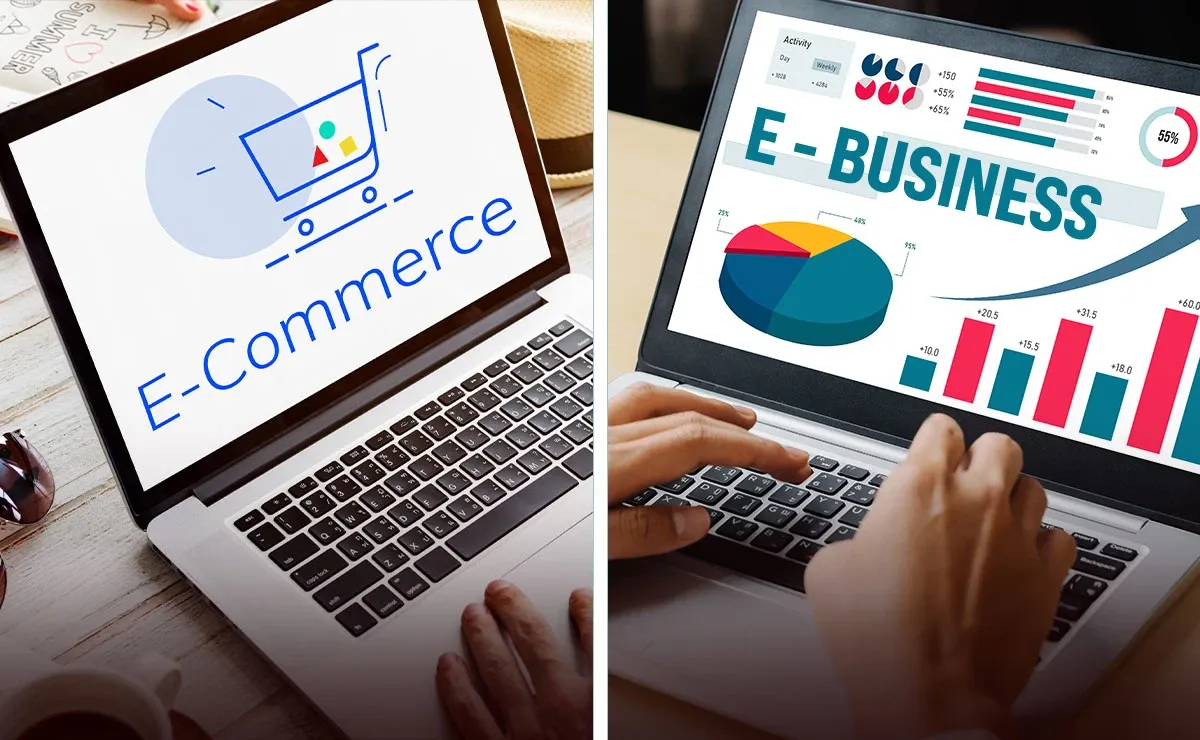What is the Difference Between eCommerce and eBusiness?

Remember when Netflix transformed from a DVD rental service to a streaming giant, or when Walmart integrated its supply chain with digital procurement systems? These actions weren't merely eCommerce moves; they represented a comprehensive eBusiness transformation that was taking place. Yet most people confuse these terms and use them interchangeably, missing critical strategic opportunities.
Both eCommerce and eBusiness involve leveraging the internet to conduct business activities, yet they differ significantly in scope, processes, and strategic objectives. While eCommerce focuses solely on the online buying and selling of products, eBusiness encompasses your entire digital ecosystem, from supplier relationships to internal operations.
Understanding this distinction is not only academic but is also strategically important. This article explains the differences between eCommerce and eBusiness, including real-world examples and best practices to consider.
What is eCommerce?

Electronic commerce, or eCommerce, is the practice of buying, selling, and exchanging goods and services using digital platforms and networks. At its core, eCommerce transforms traditional commerce by leveraging the internet and connected devices to facilitate transactions anytime and anywhere.
But eCommerce is more than simply placing items in a shopping cart and clicking “Buy Now.” It encompasses a broad ecosystem of technologies, processes, and strategies designed to create seamless, secure, and personalized shopping experiences for both sellers and buyers. Here are the key characteristics of eCommerce:
- Transaction‑Centric: The primary goal of an eCommerce business is to complete a sale or purchase.
- Customer‑Facing: Interactions occur directly between the business and its end customers.
- Public internet channels: eCommerce is reliant on public internet platforms such as websites, mobile apps, and digital marketplaces.
- Global Reach: eCommerce is not bound to a single geographic location and has global reach that connects buyers and sellers across physical boundaries.
Core Components of Modern eCommerce
1) Sales Channels
First, merchants choose where to sell, as they have various channels at their disposal.
- Branded websites built on platforms such as Shopify or Magento give full control over design, user flow, and customer data.
- Online marketplaces like Amazon, eBay, and Etsy offer instant access to large audiences and handle much of the technical infrastructure.
- Social selling on Facebook and Instagram Shops integrates shopping directly into the users’ social feeds, letting brands showcase products in context and drive engagement through discovery.
2) Product Catalog and Management
A robust product catalog system is an essential part of eCommerce, as it helps sellers maintain up‑to‑date records of product titles, descriptions, images, prices, variants, and stock levels. This structured database synchronizes in real time across all channels, ensuring customers always see accurate availability and consistent information.
3) Secure Payment Processing
At checkout, customers rely on payment gateways such as Paytm or Razorpay, as well as digital wallets like Apple Pay and Google Pay. These services manage authorization, transaction processing, fraud prevention, and adherence to security protocols like PCI DSS (Payment Card Industry Data Security Standard).
4) Order Fulfillment and Logistics
Once an order is placed, the fulfillment process begins, where sellers may handle picking, packing, and shipping in‑house, or they can outsource to third‑party logistics providers that manage warehousing, shipping, and returns. For digital products such as eBooks or online courses, automated systems deliver download links or access portals immediately.
5) Customer Experience and Support
A frictionless support infrastructure is critical for building loyalty. AI‑powered product recommendations guide shoppers to items they will love, while chatbots and help‑desk software resolve questions quickly. Prompt support reduces cart abandonment and encourages repeat purchases.
6) Marketing and Acquisition
Finally, successful eCommerce brands use a mix of strategies to attract and convert visitors. Search engine optimization draws organic traffic, paid search and social media ads target specific audiences, email campaigns keep customers informed, and affiliate partnerships expand reach. Collectively, these elements form a dynamic ecosystem that fuels expansion, elevates customer experiences, and ensures streamlined operations.
What is eBusiness?
E-business means using the internet and digital tools to run a company. This includes selling products online, providing services through websites, and managing business tasks like tracking inventory, handling customer information, and organizing employees digitally. Simply put, any business activity that uses online technology is part of e-business.
This approach helps companies work more efficiently, reach more customers worldwide, and reduce costs by moving operations online. It has changed how businesses operate by making it easier to connect with customers, suppliers, and partners anywhere in the world through digital platforms. Here are the key characteristics of an eBusiness:
- Process‑Oriented Integration: eBusiness unifies both external interactions (with customers and suppliers) and internal workflows (finance, HR, IT, marketing) under a digital umbrella.
- Multi‑Network Connectivity: Businesses leverage the public internet and secure intranets for employee access and extranets for trusted partner collaboration.
- Beyond Transactions: While eCommerce handles order placement and payment, eBusiness also automates electronic invoicing, supply‑chain alerts, HR onboarding, knowledge sharing, and more.
Core Components of eBusiness
Modern eBusiness rests on several interlocking systems that together streamline operations, enhance collaboration, and drive data‑informed decisions across the enterprise.
1) Enterprise Resource Planning (ERP)
At the heart of digital operations is ERP software, which integrates core functions such as accounting, procurement, manufacturing, inventory, and human resources into a unified database. By breaking down information silos, ERP ensures that finance teams, production managers, and HR can all access the same real‑time data, reducing errors, accelerating month‑end closes, and enabling accurate forecasting of cash flow and resource needs.
2) Customer Relationship Management (CRM)
CRM platforms capture and organize every customer touchpoint, from initial website visits to support tickets, into unified profiles. This comprehensive view enables tailored outreach, automated lead nurturing, and contextual support. Over time, CRM analytics reveal which segments yield the highest lifetime value and which campaigns drive the best return on investment.
3) Supply Chain Management (SCM)
Supply chains today span continents, involve multiple tiers of suppliers, and require constant monitoring of stock levels, shipment statuses, and quality metrics. Modern SCM solutions automate purchase orders, track shipments via integration with carriers, and trigger automatic reorders when inventory dips below defined thresholds. With built‑in demand forecasting, companies can plan production runs more accurately, minimize carrying costs, and respond rapidly to disruptions.
4) Collaboration Tools
Digital workspaces enable distributed teams to collaborate seamlessly through intranets, document management, and chat platforms. These systems create searchable knowledge repositories, maintain version control, and eliminate costly email chains while ensuring governance through role-based permissions and audit trails for global coordination.
5) Business Intelligence (BI) and Analytics
Data is only as valuable as the insights it yields. BI platforms transform raw data from ERP, CRM, and SCM systems into actionable insights through dashboards displaying key performance indicators like regional sales and inventory turnover. Advanced analytics apply machine learning to uncover patterns, predict outcomes, and recommend strategic actions, enabling confident executive decision-making based on comprehensive data analysis.
6) Security and Compliance
Sensitive financial, intellectual property, and customer data digitized require robust security, which is essential. As a result, contemporary eBusiness systems implement multi-layered authentication, data encryption, role-specific access permissions, and real-time surveillance. Regular audits and compliance with ISO 27001, GDPR, and other industry regulations prevent data breaches, protect brand reputation, and ensure legal requirements across jurisdictions.
Difference Between eCommerce and eBusiness

Understanding the distinction between eCommerce and eBusiness helps organizations allocate resources, select appropriate technologies, and design processes that align with their strategic objectives. The following table outlines the primary distinctions.
Aspect | eCommerce | eBusiness |
Definition |
eCommerce revolves around the online exchange of goods and services through digital platforms. | eBusiness encompasses all digital business processes, including transactions, operations, and collaboration. |
Purpose | The primary goal of eCommerce is to generate revenue through online sales and digital marketing. | eBusiness strives to optimize productivity, foster collaboration, and enhance strategic decision-making across an organization. |
Participants | eCommerce involves direct interactions between businesses and end customers or between consumers. | eBusiness involves multiple stakeholders, including suppliers, partners, employees, and both business and consumer audiences. |
Primary Channels | Transactions occur on websites, mobile apps, online marketplaces, and social storefronts. | Processes run on the internet, private intranets for employees, and secure extranets for trusted partners. |
Processes Covered | eCommerce manages catalog displays, cart functionality, payment gateways, and order fulfillment. | eBusiness covers supply chain management, enterprise resource planning, customer relationship management, and analytics. |
Technology Stack | Typical tools include eCommerce platforms, payment gateways, and basic inventory systems. | The technology ecosystem includes ERP, CRM, SCM, collaboration suites, business intelligence, and security frameworks. |
Strategic Context | eCommerce strategies focus on customer acquisition, conversion rates, and user experience design. | eBusiness strategies prioritize operational excellence, process automation, data integration, and long‑term agility. |
Examples | Online retailers like Amazon, marketplaces like eBay, and direct‑to‑consumer stores on Shopify. | Integrated digital enterprises like a manufacturer using ERP and supplier portals, banks automating loan approvals, and more. |
Each of these aspects highlights how eCommerce delivers fast, customer‑facing transactions, while eBusiness provides a comprehensive framework that integrates internal operations, partner collaboration, and customer engagement through digital technologies.
FAQ
Q1. What is the difference between eCommerce and M‑commerce?
Ans: eCommerce refers to any online buying and selling of goods and services via internet‑enabled devices such as desktops and laptops. Conversely, M-commerce is a specialized segment of eCommerce dedicated to mobile-based transactions, typically facilitated via apps or responsive websites.
Summing Up
The distinction between eCommerce and eBusiness isn't merely semantic—it determines whether your organization builds isolated sales channels or integrated digital ecosystems. Companies treating them as synonymous often create fragmented infrastructures that limit scalability and operational visibility.
Smart organizations recognize eCommerce as their revenue engine while positioning eBusiness as their operational backbone. This dual approach enables seamless customer experiences supported by efficient internal processes, from automated supply chains to data-driven decision making.
Your next strategic move depends on current maturity: enhance eCommerce capabilities for immediate revenue growth or invest in comprehensive eBusiness transformation for long-term competitive advantage. The most successful companies master both.

